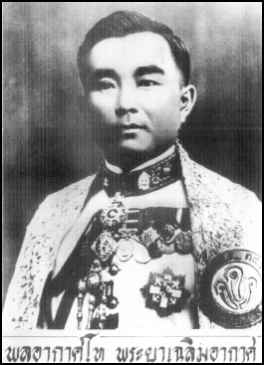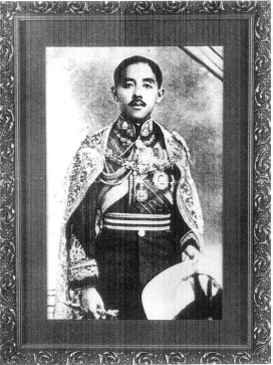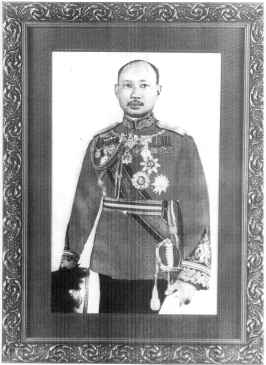
|
|
 |
|
as the first Thai to receive a flying license became known; he was later head of the Air Service which evolved into the Royal Thai Air Force. (Courtesy Royal Thai Air Force Museum) |
|
Meanwhile, back in Bangkok, the Ministry of War had authorized purchase of seven aircraft for its
proposed flying unit; three Breguet biplanes and four Nieuport II monoplanes. A fourth Breguet was bought by Chao Phraya Aphai
Pubet, a wealthy resident of Cambodian extraction, who donated the machine to the Ministry of War, such donations by the public were
to become frequent in the next decade and play an important part in building up Siam's fleet of planes. The three Thai pilots, together with the aircraft and a French mechanic, returned to their homeland by a lengthy route across Russia to Japan, witnessing a number of flying demonstrations on the way. They finally arrived back in Bangkok on November 2, 1913 Here, perhaps, one should pause and pay tribute to these pioneers who journeyed so far to learn the secrets of flight and who, in doing so, became the founding fathers of the Royal Thai Air Force. All of them went on to train hundreds of other pilots and all had distinguished careers. This was particularly true of Major Luang Sakdi, the first to receive his flying license, whose subsequent career is summarized as follows by Edward Young, a student of Thai aviation History: "From 1914 to 1932 he was head of the Air Service, and oversaw its expansion and development. He organized the first airmail service, built up the air service in the face of constant budgetary and technical problems, and after the 1932 Revolution, continued to be active in the development of commercial aviation in Siam. He was diligent, industrious, and economical. His legacy can be seen in Thailand's active involvement in aviation." The new flying unit was to be based at Don Muang, some 23 kilometers north of Bangkok, a site personally selected by Prince Chakrabongse because the land there was relatively high and thus less subject to floods in the monsoon season. As these facilities were not yet completed, however, a temporary headquarters, with hangars, was established near the race track where Van den Born had made his flights. It was here that the new aircraft were assembled with assistance from the French mechanic, and on December 29, a little over a month after their return, they were ready for the first demonstrations of Thai pilots flying over their own country. |
 |
|
Chief of the Army General Staff, who spearheaded the development of Thai aviation. (Courtesy Royal Thai Air Force Museum) |
|
Once more, Prince Chakrabongse was in attendance, together with his Russian wife, along with other
military officers. Lt.-Colonel Sakdi (he had been promoted in May in recognition of his achievments) was scheduled to be first off the
ground, in one of the Breguet biplanes, but due to engine trouble he decided to delay his flight until the next day. At 7:30 in the morning,
therefore, Major Luang Arwut (who had also received a promotion) became the first Thai pilot to demonstrate his skill before his
countrymen when he took off in a Nieuport monoplane. "The machine shot forward," reported the Bangkok Times." A cheer went up from the assembled spectators as it rose into the air and sped across the golf links. Turning at the Sala Dang end, the aviator made a circle of the course and then went over the links again to land. Bunkers seemed terribly prominent, but the aviator chose his spot and the hum of the motor died as he glided gently to earth." The first flying demonstration for the public took place on January 13, 1814, with King Vajiravudh in attendance. In his diary for that day, the King echoed the sentiments of most of the large crowd when he wrote, "I am delighted to see that we Thais are not bested by the Westerner, truly we can do whatever they can do. Further developments in Thai aviation proceeded rapidly thereafter. Don Muang was ready for occupancy within a few months, and the first plane, a Nieuport, landed there on March 8. (Bangkok's airport, it might be noted parenthetically, is the oldest in the world still being used in its original location; no road connected it with the city in the early days, the only access being by railway on the northern line, which passed the site.) On March 27, now celebrated as Royal Thai Air Force Day, the Ministry of War promoted the new section to become the Aviation Division of the Army. With Lt.-Col. Sakdi as Head and Major Luang Arwut as second-in-command, it consisted of a flying section, a flying school to train new pilots, and a workshop. Instruction of flyers on home ground had been an important part of the scheme from the beginning, and even before the move to Don Muang the Ministry had begun accepting applications. Eight army officers were selected for the first class, five of whom passed through the course successfully in 1915. Another concern was gettting a sufficient fleet of planes for the fledgling force. In view of the difficulties presented by trying to obtain spare parts from distant Europe, Colonel Praya Chalern Akas - the special title given to Lt.-Col. Luang Sakdi when he was promoted once again in June, 1914 - set about obtaining material and personnel for Siam to build his own aircraft. The first attempt, a copy of a Nieuport constructed of local wood, was not flown but used to taxi on the field. The first Thai-made plane to leave the ground was a Breguet biplane, which was successfully test-flown by Colonel Chalerm Akas on May 24, 1915. The Army began using aircraft for reconnaissance, flying at 500 to 800 meters, toward the end of 1915, and early the following year they were used on a much larger scale during maneuvers held at Ratchaburi, south-west of Bangkok. Four Breguets under Colonel Chalerm Akas were assigned to one side in the mock combat and four Nieuports under Major Tayan Pikat to the other, enabling the Army to gain valuable experience in the deployment of aircraft and operational procedures. All these activities had been followed with great interest by King Vajiravudth. The first Thai ruler to be educated abroad, he had a wide range of knowledge concerning Western affairs and was particularly conscious of the need to develop a modern army. At his coronation celebrations, in 1910, an entire day had been given over to military programs, with some 30,000 troops - the largest force ever assembled in Bangkok - taking part. In later years, he spent lavish sums to acquire new ships, arms, and other equipment and usually made a point of attending the annual maneuvers held by the Army. |
 |
|
Commander of the Army Engineers in 1911 and later Minister of Commerce and Communications. (Courtesy Royal Thai Air Force Museum) |
|
The Aviation Division was not only an extension of these programs but also one with special appeal to
the King, representing as it did the very latest in military develpment. He made the first of a number of visits to the Division's new home
soon after it moved to Don Muang and also attended the Ratchaburi maeuvers. On his second visit to Don Muang in December 1916,
after inspecting the aircraft and workshops and watching a flying demonstration, he offered the following observation. "Today I have
seen that our Aviation Division is well developed. People aroung the world believe that it is a very difficult task. But I have seen that our
Thai people have done it well without any help. All of you, from the highest to the lowest position, please accept my thanks." On July 11, 1917, Siam declared war on the Central Powers, thus entering the conflict on the side of the Allies. In June of the following year, an Expeditionary Force of 1,200 men, including an aviation contingent numbering about 340, was sent to France, the only Asian soldiers to take part in the war. Thai pilots flew only a few operational missions, toward the end of the fighting, but the lack of combat opportunities was more than compensated for by the training facilities available to them; more than 100 officers were sent fo flying schools at Istres and Avord, of whom 95 qualified as military pilots and received advanced training in observation. The aviation contingent was the first to return to Bangkok, on May 1, 1919. According to historian, Walter Vella, "The welcome arrangements were elaborate: buildings along the Chao Phraya River were decorated; fireworks were set off; the King, officials, troops, and families all greeted the returning soldiers at appointed places. The King gave each of the soldiers a medal commemorating his service in the war. And he addressed the returning members of the Expeditionary Force as comrades and as sons who had brought honor and fame to Siam, its monarch, and its people." |


|